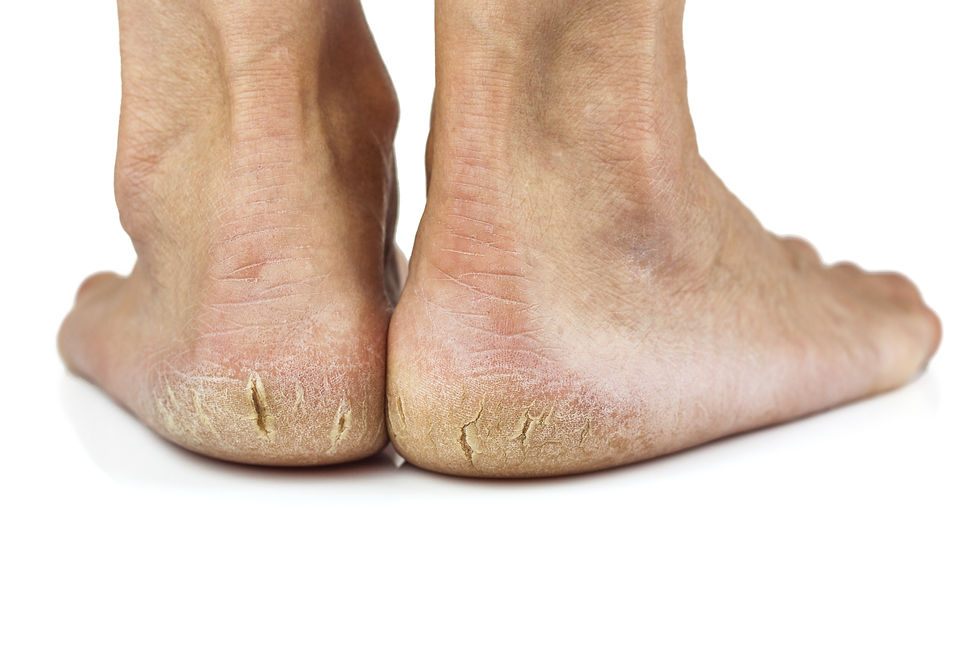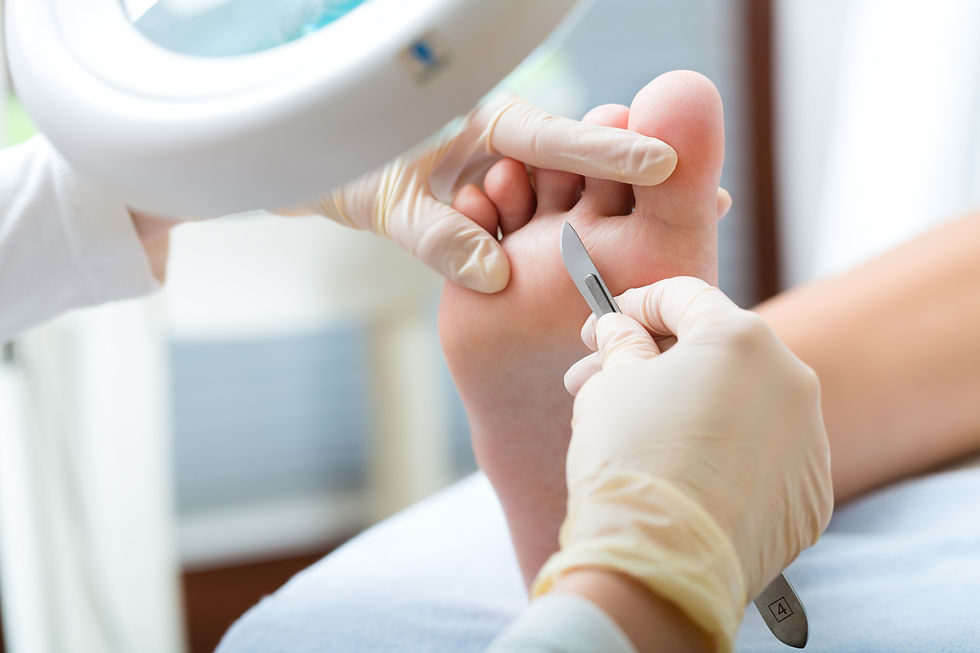It's a wart! It's a corn! It's callous!
- Lakeside Podiatry
- Apr 2, 2020
- 4 min read

Superman references aside, it can be very difficult to differentiate between warts, corns and callus when you’re not sure what you’re looking at. From the outside, all 3 often appear as similar looking areas of thickened skin. As podiatrists, we are trained to know which is which, but this post will cover some of basics on how to tell the difference, and how to prevent them!
What is callous?
Callous (hyperkeratosis) is a thickening of the surface layers of the skin in response to pressure. Whenever we walk or stand, our body weight, movements and footwear cause pressure through our feet – and when this pressure, as well as extra friction falls on particular areas of the foot, callous develops. Callus is characterised by hard, sometimes large patches of skin, usually on the soles of the feet. This hard skin is part of the body’s defence system to protect the underlying tissues.

What are corns?
Corns are similar to callous, however they are the body’s response to pressure in a very concentrated spot, as opposed to over a larger area. They often look like small circular sores that have a hard, funnel-like centre with overlying hard skin. Corns mostly occur on bony areas of the foot, as well as in between the toes. These interdigital corns may be softer due to moisture from sweating or inadequate drying between the toes after showering, and can appear white and rubbery. Corns can be painful, and if left untreated they can cause the breakdown of underlying healthy tissues which may lead to wounds or ulcers.
Both of these conditions are caused by continuous pressure in one particular area, and this can be due to any (or more than one) of the following:
Ill-fitting or inappropriate footwear (like those high heels in your wardrobe that you only pull out for special occasions)
Long periods of standing, especially on hard surfaces or flooring
A reduction in fatty padding/tissue and elasticity in the feet – this mostly affects the elderly
Deformities in bone structure (for example clawed toes or bunions), or abnormalities in the way a person walks
For both callous and corns, if the cause of the pressure is not reduced, callous and corns will return over time!
So, how do I prevent getting corns or callous you ask? Here are some suggestions on things you can do at home:
Get your shoes professionally fitted, and ensure they have enough depth and width to reduce pressure and friction within the shoe
Shop for shoes at the end of the day – feet swell over the course of the day, and by trying on shoes at this time you will have a better idea of what shoes will rub and lead to corns and callus
Wear socks to protect your feet – they provide extra cushioning to prevent rubbing and socks made from natural fibres allow your skin to breathe and stay dry
Keep in between the toes DRY – this will prevent rubbing of the skin and prevent interdigital corns.
Apply moisturiser on the feet (except for in between the toes) to keep the skin healthy and prevent callus and cracking of the skin
Please do not attempt to cut corns or callouses yourself – inside warm, moist and enclosed shoes, cuts can become infected easily!
And don’t forget, your podiatrist can help too by:
Gently removing hard callus, and corns to relieve pressure and pain
Redistributing pressure on the foot with padding or orthotics that easily fit in footwear
Using foam or silicone wedges to relieve pressure between toes
Providing education on footwear, and potential prescription of orthotics to redistribute pressure away from areas prone to callus and corns

What are warts?
Unlike callous and corns, warts (or verruca) are actually caused by the Human Papilloma Virus (HPV), not by pressure. A defining feature of warts is their “cauliflower” like appearance. However, it is also common for warts on the feet (plantar warts) overlying weight-bearing areas, to appear ‘buried’ into the skin (so you can see how it can be hard to figure out if it is a wart or not!).
A helpful diagnostic feature of plantar warts is called the ‘pinch test’. Usually plantar warts are painful when squeezed, and this is not the case for a corn or callus.
Warts can painful (as well as not very nice to look at), so here are some tips on how to prevent them:
Avoid going barefoot in communal areas (i.e. swimming pools, public bathrooms, gym change rooms), make sure to always wear thongs or other footwear
Keep your feet clean and dry – ensure to change your socks daily
Avoid direct contact with warts – for example; if you have a wart on your hand, try to avoid contact with other areas of your body. Keeping warts covered can help prevent spreading the virus to other regions of the body.
Read more about our Swift Wart Therapy.

The good news is, our Podiatrist's can help you treat all 3 of these conditions, and keep you walking and running free of pain!
Call us at Lakeside Podiatry on 5821 3006, or book an appointment online.




I’m very excited to inform everyone that I’m completely cured from HSV1&2 recently. I have used Oregano oil, Coconut oil, Acyclovir, Valacyclovir, Famciclovir, and some other products and it’s really help during my outbreaks but I totally got cured from HSV1&2 with a strong and active herbal medicine ordered from a powerful herbalist called Dr. Riaria and it completely fought the virus away my nervous system and I tested negative after 14 days of using the herbal medicine. I’m here to let everyone know that the herpes virus has a complete cure, I got rid of it with the help of Dr. Riaria and his herbal medicine. Contact him via email: drriaria@gmail.com or WhatsApp him at +2347010627760.
You can also check his website for…